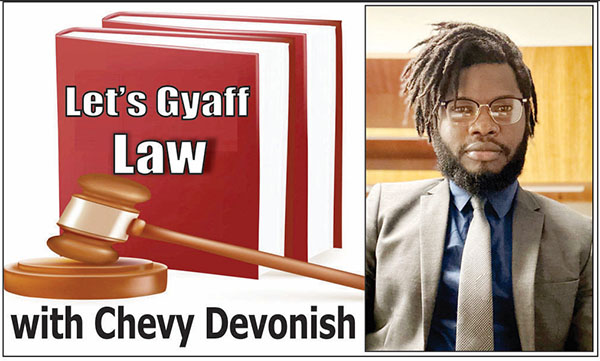 Breaking down the Sexual Offences Act
Breaking down the Sexual Offences Act
Today I will break down section 69 of the Sexual
Offences Act, Cap 8:03, Laws of Guyana (“The
SOA”).
Section 69, titled “Corroboration” in the marginal note, creates important rules regulating corroboration evidence in trials for sexual offences. Corroboration, or corroborating evidence refers to evidence which tends to strengthen, support, or confirm other existing evidence.
Origin, nature, and purpose of the rule on corroboration
Generally, a premium was/is placed on corroborating evidence. In times past, this was especially so in trials for sexual offences where the primary (and sometimes the only) evidence was the testimony of the complainant (alleged victim).
In cases where an adult alleged victim of a sexual offence was giving testimony of the offence, courts were extremely uncomfortable convicting those accused on just the testimony of the alleged victim, and so created rules which valued corroboration highly, even though corroboration evidence was not mandatory for adult alleged victims.
This made sense at the time, as supporting evidence increased the persuasiveness of testimony, and there was always a chance that the accused was not being truthful.
Additionally, in High Court trials, when alleged victims gave testimonies, judges were required to warn the jury that it was unsafe to convict the accused based on evidence (especially testimony) which has not been corroborated by other evidence. This was called a mandatory warning. No such warning was made in magistrates’ courts (for obvious reasons), although magistrates considered this rule in deciding on guilt.
Corroboration of testimony from child witnesses
Due to concerns over whether children understood the importance of being truthful, the courts made it mandatory for sworn or unsworn evidence given by children to be corroborated. This mandatory need for corroboration eventually found its way into many statutes, including Guyana’s own Evidence Act, Cap 5:03, Laws of Guyana “the EA”).
Section 61 (3) of the EA says that a person cannot be convicted of certain offences under the Summary Jurisdiction Offences Act, and the Criminal Law Offences Act based on unsworn evidence from a child unless that evidence is corroborated by some other material evidence implicating the accused.
Meanwhile, section 71 (3) of the EA, which applies more generally, states that in any trial where a child gives unsworn evidence, and that evidence is the main evidence against the accused, the accused cannot be convicted of that offence unless there is some other evidence supporting and confirming the child’s unsworn evidence.
Abolition of the need for corroboration and judicial warning in sexual offences cases
Section 69 (1) of the SOA abolishes these requirements for corroboration in trials for sexual offences. The section provides that where the alleged victim accuses someone of committing a sexual offence against them, it is not necessary for the evidence of the alleged victim (including sworn or unsworn evidence from a child alleged victim) to be corroborated (strengthened or confirmed by any other evidence) for the accused to be found guilty.
Section 69 (1) therefore means that if A accuses B of rape, whether A is a child giving sworn or unsworn evidence, there is no need for the evidence given by A to be confirmed or supported by any other testimony, documentary, or other evidence for the accused to be found guilty. Instead, B can be convicted if the magistrate in the magistrates’ court, or the jury in the High Court finds that testimony convincing enough.
The provision goes on to say if the trial is taking place in the High Court, the High Court judge cannot tell the jury that it would be unsafe to find the accused person guilty of the evidence of the alleged victim if there is no other evidence strengthening or confirming the testimony of the alleged victim.
Section 69 (2) states that sections 61 (3) and 71 (3) of the EA (mentioned above) do not apply to offences under the SOA.
Why was the need for corroboration and mandatory judicial warnings abolished
Parliament’s reason for abolishing the premium on corroboration, for mandatory judicial warning, was simple.
By nature, sexual offences are committed in places where the only witnesses are likely to be the alleged victim and the accused. Sexual offences are not always violent so there is no guarantee of injury to either the alleged victim or the accused. Additionally, it is common for the alleged victim to not tell anyone about what transpired.
It is also common for victims of sexual offences to never get a medical examination, and where a medical examination is done, it is common for there to only be evidence of sexual activity, which is not conclusive of an offence.
For these and a myriad of other reasons, sexual offences are notoriously difficult to prove, and the insistence on corroboration, and warnings by judges that a conviction in the absence of corroboration was unsafe increased the unlikelihood of a conviction.
As such, removing the need for corroboration and for mandatory warnings increases the chances of obtaining a conviction while maintaining the safeguards against unsafe conviction. Much attention must still be paid to the believability of an alleged victim’s story, and anything the accused says in his defence.
This provision has several impacts, including assuring victims of sexual offences that their words can be enough to secure the conviction of an accused. This will undoubtedly increase the likelihood that sexual offences are reported.
Section 69 of the SOA is therefore yet another innovative way in which Guyana’s lawmakers have sought to protect victims of sexual violence in Guyana.




